Lead paint threatens to undo California’s biggest residential cleanup, officials warn. But they’re doing little to fix it
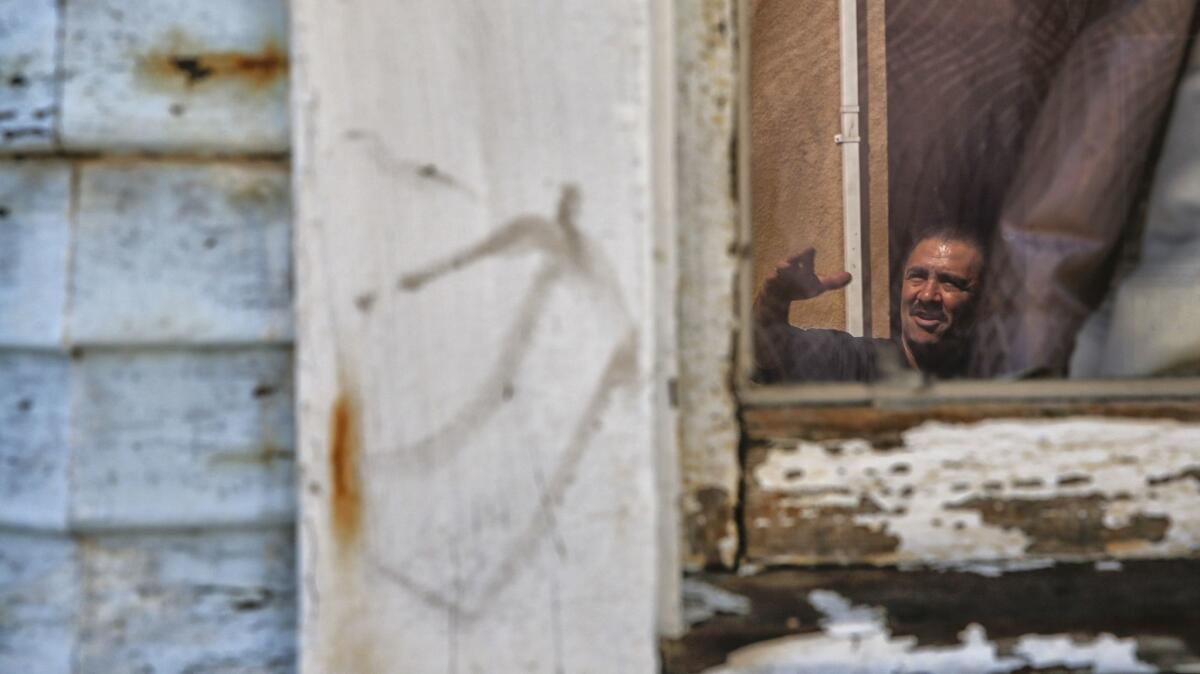
Officials have long known that children across a swath of southeast Los Angeles County are exposed to brain-damaging lead from two distinct sources: pollution from a now-shuttered battery recycling plant and lead paint in the walls of their homes.
The state has begun cleaning soil contamination from yards near the Exide Technologies plant in California’s biggest-ever lead cleanup. But bureaucratic mistakes and a lack of cooperation between state and local agencies have blocked efforts to fix lead house paint, state records reviewed by The Times and interviews show.
The result, officials acknowledge, is that children in the area remain at risk of lead poisoning.
Failures occurred at multiple levels. State agencies let scarce lead abatement money slip away and refused to tell local officials which homes were in need of remediation. And the county health department, now in line to receive millions to remove lead paint from hundreds of homes, has not repaired any homes using federal grant money awarded for that purpose more than a year ago.
California regulators in charge of the project have repeatedly warned that unaddressed paint could recontaminate the soil and undo the taxpayer-funded remediation. But years into the cleanup, authorities have fixed lead paint at only a tiny fraction of the 21,000 housing units in the area.
The state blamed inaction on limitations in its authority and said other agencies must respond. County health officials cited funding constraints.
One obstacle has been longstanding antagonism between the state, which is responsible for soil cleanup, and the county, which has authority over paint.
Los Angeles County public health director Barbara Ferrer said there were “issues that the state has had — legal issues, mostly — about sharing some information with us that’s stood in the way,” but pledged to cooperate with state officials “to identify properties where it makes sense for us to start with the lead-paint remediation because the soil remediation has happened.”
“We have an obligation for government to work here,” Ferrer said.
The state Department of Toxic Substances Control said it is referring properties with flaking paint to state, local and federal authorities with greater power to address lead paint.
The department “is committed to partnering with these other agencies and affected residents to obtain resources to stabilize or abate lead-based paint hazards,” department spokeswoman Rosanna Westmoreland said. “We’re trying to do the best with the authority that we have.”
Community leaders see the failure to address lead paint as another example of the state’s slow, piecemeal approach to protecting the largely working-class Latino residents living near the former lead-acid car battery recycling plant. Gov. Jerry Brown’s administration plans to remove lead-contaminated soil from the 2,500 worst-polluted properties surrounding the Exide facility and pass over thousands of others, an approach neighborhood groups and health officials say will leave behind a scattershot pattern of safe and contaminated land.
“There’s no comprehensive solution and nobody will work together,” said Jane Williams, who directs California Communities Against Toxics.
Tired of waiting for the government, Juanita Marquez is taking it upon herself to fix the lead paint peeling off the side of her Boyle Heights house.
“By the time they come around to do it, if they ever do, it will be too late,” the retired tax preparer said. “If I wait for them, I don’t think it will ever get done.”
Ubiquitous hazard
Lead-based paint was banned in 1978 but remains the leading cause of lead poisoning in children nationwide. Authorities presume it is present in all homes built before the ban, including millions in California and virtually all residences in the cleanup zone stretching more than 1.7 miles from the closed Exide plant.
Health officials say few other neighborhoods suffer the double contamination seen in those communities from the combined effect of plant emissions and house paint. Such conditions put children at heightened risk of developmental and behavioral problems, lost IQ points and other irreparable damage. The toxic metal is most dangerous to young children, who are more likely to ingest contaminated soil or dust.
At least 1,400 people under age 21 in ZIP codes surrounding Exide — 3.68% — had elevated blood lead levels between 2011 and 2015, according to the L.A. County Department of Public Health. The actual number is significantly higher because only a fraction of people are tested.
Behind the scenes, state toxics regulators have repeatedly voiced concerns that lead paint places the whole project at risk. Records show top officials have for years met and corresponded with other agencies about addressing paint hazards, but those efforts failed to result in many cleanups.
The Department of Toxic Substances Control warned in a 2016 document that “unless all sources of lead contamination are appropriately addressed in a coordinated, comprehensive manner, the problem of lead poisoning of residents will continue.” Last year the department described peeling paint as an “ongoing health hazard to residents.”
This year, the department has at least twice asked county officials for help in preventing the recontamination of soil. Department director Barbara Lee wrote in January that lead-paint hazards “threaten the efficacy of our cleanup program and, more importantly, continue to pose a risk to public health.”
At big lead cleanups elsewhere, including in Omaha, authorities have dealt with the threat of recontamination by cleaning residential soil and house paint simultaneously.
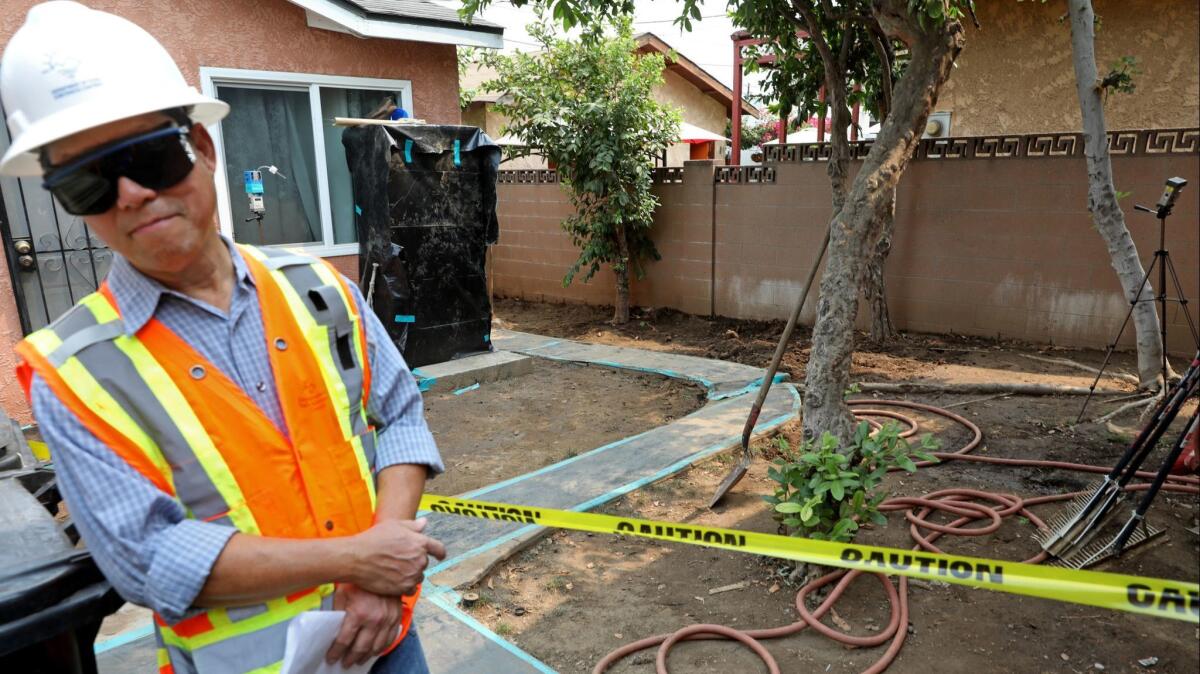
Missed opportunities
In California, state records and interviews show regulators’ efforts to address lead paint have been derailed by bureaucratic spats and other missteps.
One setback came in 2016, when the state Department of Community Services and Development sought a $2.5-million federal paint abatement grant to prevent the lead poisoning of 125 children in the Exide area. The request was rejected by the U.S. Department of Housing and Urban Development because the state missed the application deadline, according to a letter The Times obtained under the California Public Records Act.
A Community Services and Development spokesman blamed “technical difficulties” when trying to submit an online application shortly before the deadline.
A lack of cooperation has also prevented the use of already available money.
A City of Los Angeles official who spoke on the condition of anonymity said the city was unable to clean any Exide-area homes of lead-paint hazards using a $3.5-million federal grant because the Department of Toxic Substances Control would not share a list of addresses and sampling results for properties on the cleanup list.
Starting more than a year ago, the two agencies tried to direct some of the city’s lead-paint money to Boyle Heights homes flagged for soil cleanup. But the state was so concerned about privacy and potential litigation that it would not share information on those properties unless the city signed a confidentiality agreement, the city official said.
That didn’t happen, according to the city. So all 161 housing units cleaned were in other neighborhoods.
The Department of Toxic Substances Control, which for several years kept property-specific sampling results secret on privacy grounds, had discussions with the city in 2017 about sharing that data “while protecting confidential information of owners and residents,” Westmoreland said.
In March, the department changed its position, posting that information on its website.
But it was too late for Boyle Heights residents — by then, the city’s lead-paint funds were all used up.
It took more than two years to resolve a similar privacy dispute between state agencies over the sharing of blood-test results from Exide-area children. A state health department analysis of the readings later found that young children living near the facility were more likely to have high blood-lead levels than their counterparts elsewhere in L.A. County and that lead paint in older homes, which are more common closer to the plant, played a significant role.
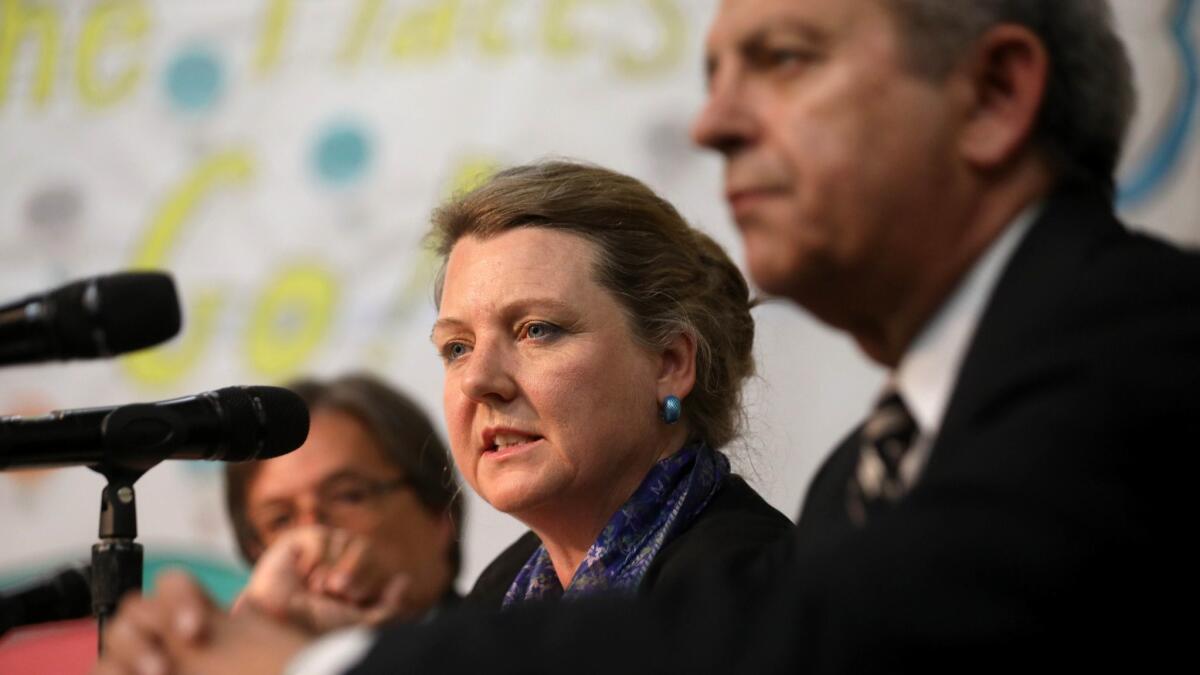
Thousands tested
Though authorities have tested the paint on thousands of properties, they have offered no conclusions about how many need remediation.
In a 2016 analysis of 437 properties, state regulators estimated about 1 in 4 with children age 6 or younger had lead paint on home exteriors. It would cost up to $40 million to fix paint hazards across the cleanup zone, the state projected at the time.
Recent state sampling results analyzed by The Times show about 4,300 of more than 7,300 building exteriors tested had lead paint at or above federal standards. Nearly one-third of those exceeding paint standards are on the state’s priority list for soil cleanup, the records show.
State toxics regulators said they intended the paint readings to be used by the county health department and other local jurisdictions to identify homes needing abatement work.
But county health officials said they chose not to act on those results because they presume all homes in the area have lead paint and that their condition is more important. Abatement is not typically done unless paint is “chipping, flaking, or otherwise deteriorating,” the health department said.
As of May, the Department of Toxic Substances Control had referred a few dozen properties in the cleanup zone for lead-paint abatement. Westmoreland said the agency “does not want to raise unrealistic expectations in the community about the ability to qualify,” and recommends only homes that “appear to be the most likely candidates” based on federal criteria.
Scarce funds
The state’s handling of the Exide cleanup is under added scrutiny because it is partly to blame for the mess. Before the facility’s closure in 2015, state regulators had allowed it to operate on a temporary permit for more than three decades, despite a history of air pollution and hazardous waste violations.
They now oversee a long-delayed soil cleanup of surrounding neighborhoods that is moving forward more slowly than anticipated. It relies on more than $190 million in taxpayer funds earmarked for soil, not paint.
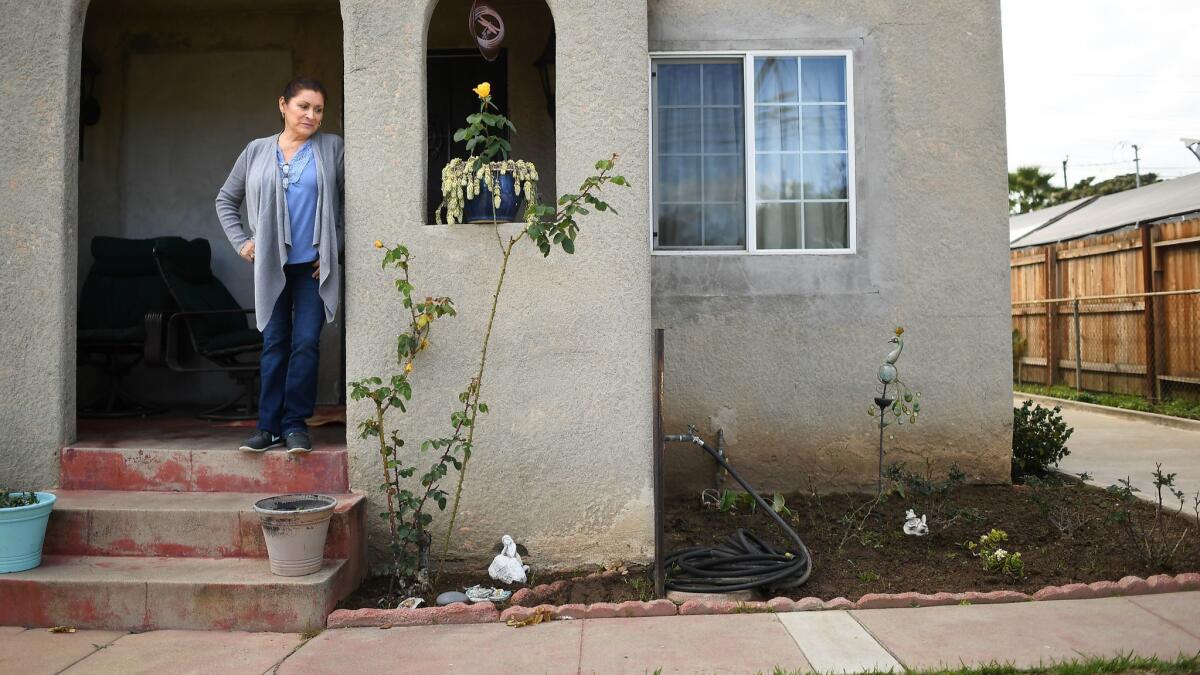
Officials have so far secured a few million dollars for lead-paint abatement, which can cost more than $10,000 per housing unit and is in high demand nationwide. They acknowledge it is nowhere near enough to fix the problem.
The Department of Toxic Substances Control has stabilized lead paint on the exteriors of six homes using a $130,000 grant from the U.S Environmental Protection Agency. State and local officials have fixed paint at about a dozen other homes in the area in recent years using federal grant money.
The county health department has been under pressure from state lawmakers to begin using a $3.4-million HUD grant it won in June 2017 to clean paint from 180 housing units with low-income families with young children, including 80 near Exide. The county said the date for starting work was delayed by grant requirements, including a request by federal officials to increase the number of units remediated.
More help could come from a tentative legal settlement over another environmental disaster: the Aliso Canyon gas leak. Southern California Gas Co. in August agreed to pay the county $5.2 million for lead-paint abatement in the Exide area — enough to take care of about 350 homes.
Ferrer, the county public health director, pledged to move quickly and predicted paint remediation would begin by October.
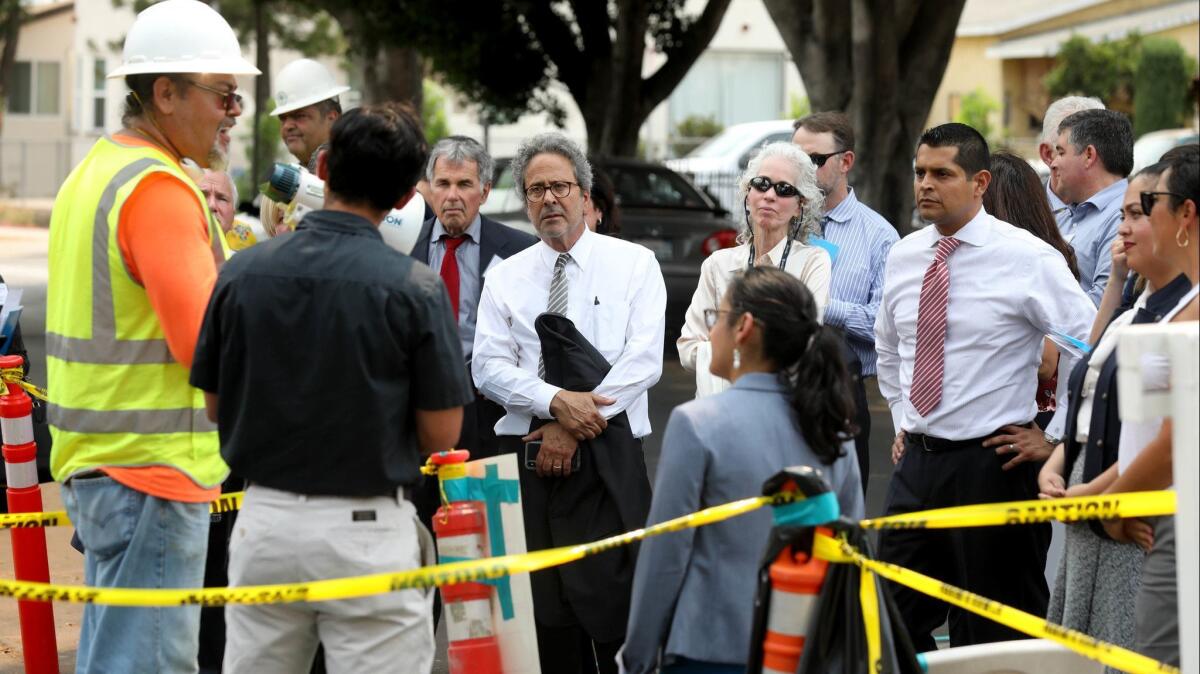
Cooperation lacking
Rocky relations between state and local officials appear to have hindered a comprehensive solution to lead hazards.
The Department of Toxic Substances Control is distrusted by many in the community while county officials have criticized the Brown administration’s plans and urged changes to speed and strengthen the project. The state has pointed the finger back at the county, saying it ought to do more to address lead hazards in the community.
Despite talk of increased collaboration, California lawmakers say state regulators have continued to resist working with local officials who have primary responsibility over lead-paint remediation. Legislators were concerned enough that they inserted language into the state budget this year intended to force the Department of Toxic Substances Control to coordinate with county health officials in offering residents blood-lead testing, interior cleaning and lead-paint abatement.
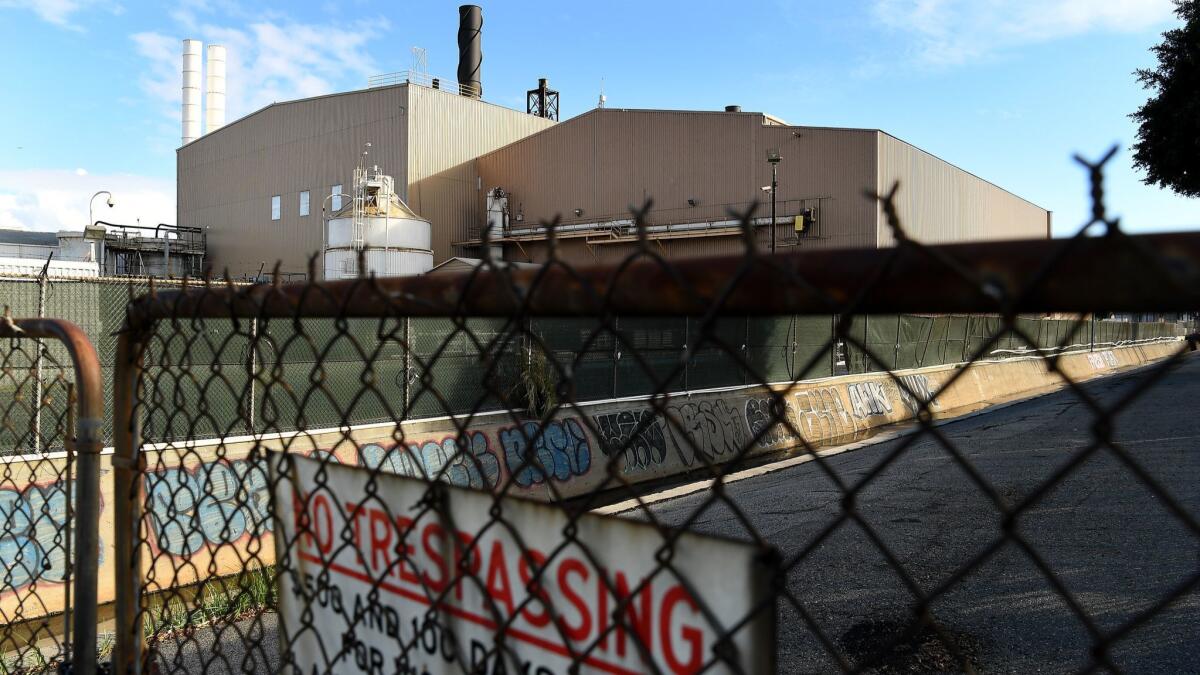
Cooperation has been a problem since at least 2015, when state records show Toxic Substances Control director Lee wrote county health officials about a 16-month-old boy whose family informed the state of test results showing elevated blood lead levels of seven or eight micrograms per deciliter. Tests at the Maywood home found the yard and house paint contaminated with lead.
“The lead-based paint represents a source of exposure or soil recontamination that could threaten the health of the children in the home,” Lee wrote, asking the county to look for funding to fix the paint.
Soil was cleaned at the home a few months later, a department spokeswoman said.
But not the lead paint, according to the boy’s grandparents, Benny and Rose Trujillo.
“You could say they did an incomplete job,” Benny Trujillo said in July. “I mean, it kind of defeats the purpose of what they’ve done to the whole yard.”
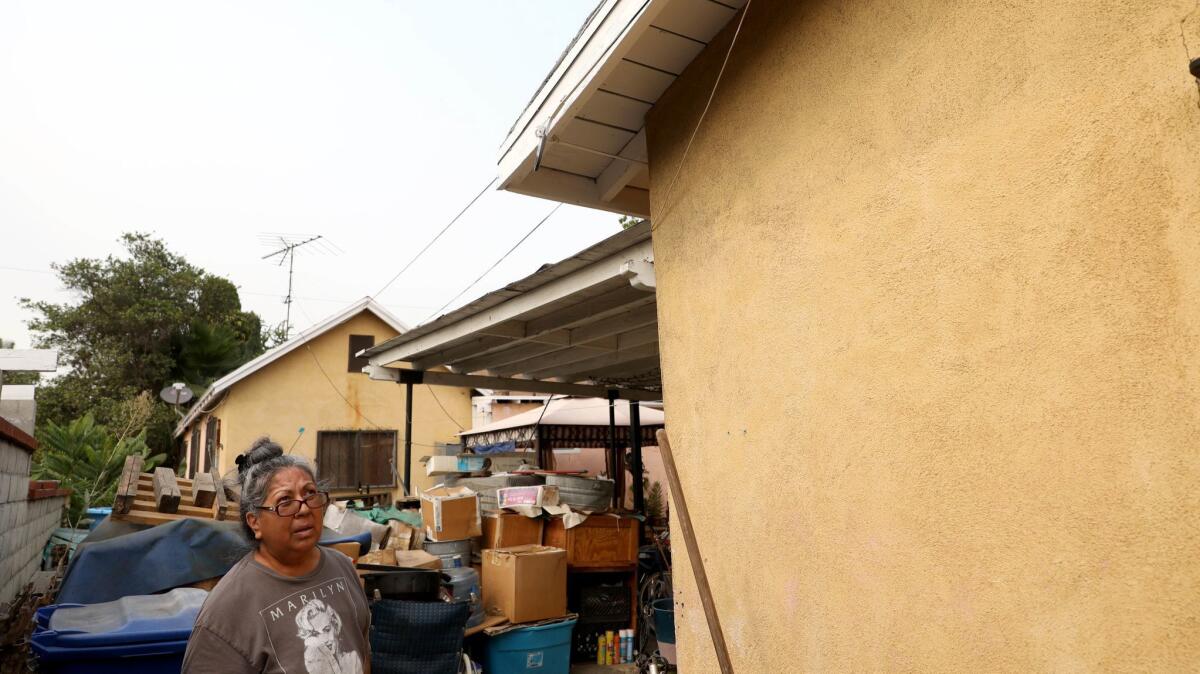
In a statement, the county health department said the child “received appropriate medical attention” and that it could not determine “whether lead paint was abated or not at this property.”
The health department said it does not typically address lead-paint hazards unless a child’s blood-lead levels exceed its threshold of two consecutive readings of 10 micrograms per deciliter. Fixing lead paint is the responsibility of homeowners, the department said, and it “does not directly abate lead paint hazards” unless public financing is available.
County health officials visited after questions from The Times, Rose Trujillo said. They told her they realized the chipping paint on their home hadn’t been cleaned and asked if the family wanted it removed.
“I said why not,” but she has not yet heard a cleanup date. While they wait, paint is still peeling off the home, where four children under the age of 16 live.
The blood-lead levels of their youngest grandson went down after their soil was replaced, the Trujillos said. But he still plays outside in the dirt, making mud pies.
Times staff writer Ben Poston contributed to this report.
More to Read
Sign up for Essential California
The most important California stories and recommendations in your inbox every morning.
You may occasionally receive promotional content from the Los Angeles Times.











